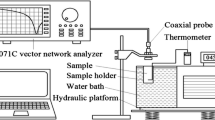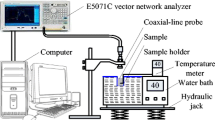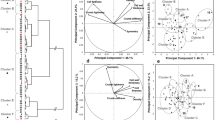Abstract
Peanuts are taken through routine postharvest procedures to assess quality, establish the grade, and determine the amount of revenue that the farmer will be allotted. Moisture content and meat content are examples of parameters determined to assess the grade of the peanuts. Such parameters are assessed for bulk samples usually with mass > 1 kg, and the resulting values are averages of peanuts within the bulk sample. Such processes are destructive and lack provision for assessment of single, in-shell peanuts. Thus, the characterization of single, in-shell peanuts was investigated by measuring the shift in resonant frequency and the change in cavity transmission characteristics caused by each peanut once inserted into a resonant cavity connected to a vector network analyzer (VNA). Such microwave measurements were taken for over 300 in-shell peanuts at 22 °C. The peanuts were divided into seven categories based on custom fillings to simulate diseased and damaged peanuts. One category, serving as the control, consisted of intact peanuts, while the other categories consisted of peanuts filled with coffee, cornstarch, and/or a single kernel. The measured resonant-cavity parameters and the calculated dielectric properties provided a means to characterize each in-shell peanut. Statistical analysis was performed to assess differentiation between the seven categories using those parameters. Kruskal–Wallis One-Way ANOVA on Ranks, Tukey test, and Dunn’s Method were used to determine which categories were statistically significantly different from each other for each parameter at the 95% confidence interval. Lastly, artificial intelligence was used to investigate the creation of models to accurately classify the peanuts.










Similar content being viewed by others
Data Availability
No datasets were generated or analyzed during the current study.
Notes
Mention of company or trade name is for description purposes only and does not imply endorsement by the USDA. The USDA is an equal opportunity provider and employer.
References
Altschuler H (1963) Dielectric constant. In: Sucher M, Fox J (eds) Handbook of Microwave Measurements, vol 2. Polytechnic Press, Brooklyn, NY, pp 495–546
Bukowski M, Ates AM (2023) Georgia leads U.S. production of peanuts. USDA Economic Research Service. https://www.ers.usda.gov/data-products/chart-gallery/gallery/chart-detail/?chartId=106192 Accessed 7 September 2023
Davidson JI, Whitaker TB, Dickens JW (1982) Grading, cleaning, storage, shelling and marketing of peanuts in the United States. Peanut Sci Technol 571–623
Kandala CVK (2004) Moisture determination in single peanut pods by complex RF impedance measurement. IEEE Trans Instrum Meas 53(6):1493–1496. https://doi.org/10.1109/TIM.2004.834058
Kandala CV, Butts CL (2006) Nondestructive moisture content determination of in-shell peanuts by rf impedance method. Trans ASABE 49(3):729–733
Kandala CV, Nelson SO (2007) RF impedance method for nondestructive moisture content determination for in-shell peanuts. Meas Sci Technol 18(4):991–996. https://doi.org/10.1088/0957-0233/18/4/005
Kraszewski AW, Nelson SO (1992) Resonant microwave cavities for sensing properties of agricultural products. Trans ASAE 35(4):1315–1321
Kraszewski AW, Nelson SO (1993a) Moisture content determination in single peanut kernels with a microwave resonator. Peanut Sci 20(1):27–31. https://doi.org/10.3146/i0095-3679-20-1-8
Kraszewski AW, Nelson SO (1993b) Nondestructive Microwave measurement of moisture content and mass of single peanut kernels. Trans ASAE 36(1):127–134. https://doi.org/10.13031/2013.28323
Kraszewski AW, Nelson SO, You TS (1989a). Sensing dielectric properties of arbitrarily shaped biological objects with a microwave resonator. IEEE MTT-S International Microwave Symposium Digest 1:187–190
Kraszewski AW, You TS, Nelson SO (1989b) Microwave resonator technique for moisture content determination in single soybean seeds. IEEE Trans Instrum Meas 38(1):79–84. https://doi.org/10.1109/19.20002
Lewis MA, Trabelsi S, Nelson SO (2016) Assessing the utility of microwave kernel moisture sensing in peanut drying. Appl Eng Agric 32(6):707–712
Nelson SO (1973) Electrical properties of agricultural products - a critical review. Trans ASAE 16(2):384–400
Nelson SO (2010) Fundamentals of dielectric properties measurements and agricultural applications. J Microw Power Electromagn Energy 44(2):98–113. https://doi.org/10.1080/08327823.2010.11689778
Rago AM, Cazon LI, Paredes JA, Molina JPE, Conforto EC, Bisonard EM, Oddino C (2017) Peanut smut: from an emerging disease to an actual threat to argentine peanut production. Plant Dis 101(3):400–408
Rubinger CPL, Costa LC (2007) Building a resonant cavity for the measurement of microwave dielectric permittivity of high loss materials. Microw Opt Technol Lett 49(7):1687–1690. https://doi.org/10.1002/mop.22506
Trabelsi S, Lewis MA, Nelson SO (2016) Microwave moisture meter for in-shell peanut kernels. Food Control 66:283–290
University of Georgia (2003) World Geography of the Peanut. http://lanra.anthro.uga.edu/peanut/ Accessed 20 February 2007
Venkatesh MS, Raghavan GSV (2005) An overview of dielectric properties measuring techniques. Can Biosyst Eng 47:7.15-17.30
Von Hippel AR (1954) Dielectric materials and applications. The Technology Press of MIT. and John Wiley and Sons, New York, NY
Wei Z, Wang J, Zhang W (2015) Detecting quality of peanuts during storage using electronic nose responses combined with physicochemical internal methods. Food Chem 177:89–96
Funding
This study was supported in part by the Mars-Wrigley CompanyFootnote 1 and USDA-ARS CRIS Project No. 3072–21220-008-00D under Trust Fund Cooperative Agreement # 58–3072-9–004.
Author information
Authors and Affiliations
Contributions
Conceptualization: S.T.; Methodology: M.L. and S.T.; Formal analysis and investigation: M.L. and S.T.; Writing – original draft preparation: M.L.; Writing – review and editing: M.L., S.T., R.B., and K.C.; Funding acquisition: R.B., K.C., and S.T.; Resources: R.B. and K.C.; Supervision: S.T.
Corresponding author
Ethics declarations
Competing Interests
The authors declare no competing interests.
Additional information
Publisher's Note
Springer Nature remains neutral with regard to jurisdictional claims in published maps and institutional affiliations.
Rights and permissions
About this article
Cite this article
Lewis, M.A., Trabelsi, S., Bennett, R.S. et al. Utilization of a Resonant Cavity for Characterization of Single In-Shell Peanuts. Food Anal. Methods (2024). https://doi.org/10.1007/s12161-024-02620-x
Received:
Accepted:
Published:
DOI: https://doi.org/10.1007/s12161-024-02620-x




